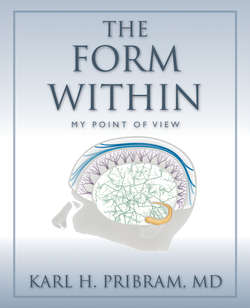Читать книгу The Form Within - Karl H Pribram - Страница 40
На сайте Литреса книга снята с продажи.
An Early Intuition
ОглавлениеMy initial thought processes and the research that germinated into this section of The Form Within reinforced my deeply felt intuition that the “feature detection” approach to understanding the role of brain processes in organizing our perceptions was of limited explanatory value.
Michael Polanyi, the Oxford physicist and philosopher of science, defined an intuition as a hunch one is willing to explore and test. (If this is not done, it’s just a guess.) Polanyi also noted that an intuition is based on tacit knowledge; that is, something one knows but cannot consciously articulate. Matte Blanco, an Argentine psychoanalyst, enhanced this definition by claiming that “the unconscious” is defined by infinite sets: consciousness consists of being able to distinguish one set of experiences from another.
The “feature detection” story begins during the early 1960s, when David Hubel and Torsten Wiesel were working in Stephen Kuffler’s laboratory at the Johns Hopkins University. Hubel and Wiesel had difficulty in obtaining responses from the cortical cells of cats when they used the spots of light that Kuffler had found so effective in mapping the responses in the optic nerve. As so often happens in science, their frustration was resolved accidentally, when the lens of their stimulating light source went out of focus to produce an elongation of the spot of light. The elongated “line” stimulus brought immediate results: the electrical activity of the cat’s brain cells increased dramatically in response to the stimulus and, importantly, different cells responded selectively to different orientations of the elon-gated stimulus.
During the late 1960s and early 1970s, excitement was in the air: like Hubel and Wiesel, many laboratories, including mine, had been using microelectrodes to record from single nerve cells in the brain. Visual scientists were able to map the brain’s responses to the stimuli they presented to the experimental subject. Choosing the stimulus most often determined what would be the response they would obtain.
Hubel and Wiesel settled on a Euclidian geometry format for choosing their visual stimulus: the bull’s eye “point” receptive fields that characterized the retina and geniculate (thalamic) receptive fields could be shown to form lines and planes when cortical maps were made. I referred to these results in Chapter 3 as making up “stick figures” and that more sophisticated attempts at giving them three dimensions had essentially failed.
Another story, more in the Pythagorean format, and more compatible with my intuitions, surfaced about a decade later. In 1970, just as my book Languages of the Brain was going to press, I received a short reprint from Cambridge University visual science professor Fergus Campbell. In it he described his pioneering experiments that demonstrated that the form of visual space could profitably be described not in terms of shape, but in terms of patterns of their spatial frequency. The frequency was that of patterns of alternating dark and white stripes whose fineness could be varied. This mode of description was critical in helping to explain how the extremely fine resolution of a scene is possible in our visual perception. Attached to this reprint was a note from Fergus: “Karl—is this what you mean?” It certainly was!!
After this exciting breakthrough, I went to Cambridge several times to present my most recent findings and to get caught up with those of Campbell and of visual scientist Horace Barlow, who had recently moved back to Cambridge from the University of California at Berkeley, where we had previously interacted: he presenting his data on Cardinal cells (multiple detectors of lines) and I presenting mine on the processing of multiple lines, to each other’s lab groups.
Campbell was showing that not only human subjects, but brain cells respond to specific frequencies of alternating stripes and spaces. These experiments demonstrated that the process that accounts for the extremely fine resolution of human vision is dependent on the function of the brain cortex. When the Cambridge group was given its own sub-department, I sent them a large “cookie-monster” with bulging eyes, to serve as a mascot.
Once, while visiting Fergus’s laboratory, Horace Barlow came running down the hall exclaiming, “Karl, you must see this, it’s right up your alley.” Horace showed me changes produced on a cortical cell’s receptive field map by a stimulus outside of that brain cell’s receptive field. I immediately exclaimed, “A cortical MacIlvain effect!” I had remembered (not a bad feat for someone who has difficulty remembering names) that an effect called by this name had previously been shown to occur at the retina. Demonstrating such global influences on receptive fields indicated that the fields were part of a larger brain network or web. It took another three decades for this finding to be repeatedly confirmed and its importance more generally appreciated by the neuroscience community.
These changes in the receptive fields are brought about by top-down influences from higher-order (cognitive) systems. The changes determine whether information or image processing is sought. Electrical stimulation of the inferior temporal cortex changes the form of the receptive fields to enhance information processing— as it occurs in communication processing systems. By contrast, electrical stimulation of the prefrontal cortex changes the form of the receptive fields to enhance image processing—as it is used in image processing such as PET scans, fMRI and in making correlations such as in using FFT. The changes are brought about by altering the width of the inhibitory surround of the receptive fields. Thus both information and image processes are achieved, depending on whether communication and computation or imaging and correlations are being addressed.
15. Cross sections of thalamic visual receptive fields (n) showing the influence of electrical stimulation of the inferior temporal cortex (i) and the frontal cortex (f)
